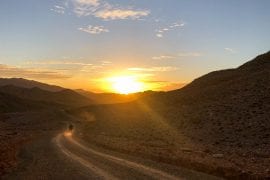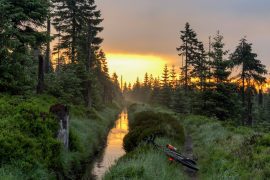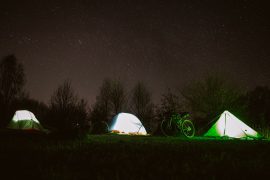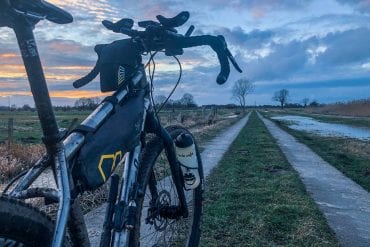Let’s be clear from the beginning: the Trans Balkan Race is a real challenge and cannot be overestimated. Bea and Luca have built a track through the Balkans that is second to none: very challenging trails and tracks, remote landscapes with long sections without catering and a weather/climate that constantly increases the level of difficulty.
Or as Brian said it so beautifully:
“It was certainly the most intense race I’ve ever done. Thank you for this masterpiece of ultra cycling.”
And he has now ridden it twice and was certain after the race: this thing is more challenging than the Silk Road Mountain Race, which Brian finished in the same year as Tobias and me.

I rode 420 kilometres of the race, up to Check Point 1. Then, unfortunately, I scratched and made a virtue of necessity and turned the Trans Balkan Race into a Trans Balkan Tour without further ado.
But first things first…
Trans Balkan: The race

I have to say that I misjudged the Trans Balkan Race. On the other hand, I didn’t, because this year the route was changed again and made tougher. My planning and assessment were based on Brian’s information from last year and the other information I could find on the internet. Brian cycled around 200-220km a day last year – I then assumed that 180km was a good basis for my planning.
However, I already realised that the track would be more challenging than probably anything I had experienced up to that point. Even if you know that in theory, it’s different when you actually ride it.

Then there was the weather, which didn’t look good for the start and the first few days: Thunderstorms and heavy rain were forecast. And the weather delivered!
We lined up for the start in light rain. I was full of anticipation and optimistic. Just in time for the start, the heavy rain began, but it subsided after an hour. The sun came out and it got warm. So I stopped, took off my rain gear and packed it away. “Now I know why it’s called bikepacking,” said one of the riders.
The first few kilometres were from Slovenia to Italy and back again and then to Croatia. I didn’t even realise it, because I suddenly lost energy and became slower and slower. At the beginning I was still able to position myself well in the front of the field, but then I was simply passed by. I had no more power and my heart rate went up. In the end, I barely had any power left on the pedals and was on the verge of shutting down.

Fortunately, I came to a spring where I followed my instinct and drank a lot and took Elotrans, electrolytes and a gel. I was simply dehydrated and had forgotten to drink, which was due to the rain and then accelerated by the sun.
Naturally, my body was exhausted as a result and this was to take its toll in the coming days. But the engine started up again and I felt much better later on. I moved forwards again and was able to find my rhythm.

And as my performance improved, the rain came again. And not just like that, but in the form of heavy thunderstorms and torrential rain. I’ve never experienced anything like it. It rained so hard that I couldn’t see anything at times. The already difficult paths became raging torrents in which you had to ride uphill. On top of that, there was lightning striking left and right. I therefore always tried to ride close to the edge to get some protection from the trees.
One look at the average speed was enough to realise that 200 km or even just 180 km would be nothing today. So I reduced myself to the 150 kilometres a day that I would have to ride in any case to arrive on time. So I pedalled on through the rain and reached the next rest stop, which turned out to be a hotel, at around 8.30 pm. Wonderful, so I decided to spend the night here and dry myself and my clothes.

And when I went to the restaurant for a bite to eat, there they all were, who I thought I would only see again at the finish. So I wasn’t as bad as I thought, I was just a bit slower.
The next day should be better in terms of weather. It was finally sunny, but the trails were still wet and full of large puddles that were almost small lakes. This made riding difficult, but it was still better than constant rain. I slowly got used to the strain and climbed all the hills at my own pace. The climbs were mostly long, sometimes up to 8 kilometres or more. Unfortunately, the previous track was exclusively in the forest. I was in Croatia by now, but I didn’t see much other than trees. Always long and steep tracks and lots of trees.
After only managing 150 kilometres on the first day, I wanted to do the 180 kilometres on the second day to see what I could do. When I rolled into Gospić in the evening in perfect weather, I had reached my goal for the day and was happy with myself again.

Nutrition was also important for me, which I didn’t manage so well at the Bohemian Border Bash. My body refused to eat due to the exertion. I wanted to prevent that this time and make sure and force myself to eat. Because it doesn’t work without calories. I envy the participants who can just eat, who are hungry and then get something down. I realised on the first evening that I was again struggling to get dinner down and eat enough.
However, this time I found a good way to compensate for this. The magic word is “squeezies”. These small portions of fruit puree baby food are available everywhere there and I had already brought many packs with me from Germany. They are easy for me to digest, I can eat them whenever I want and they provide energy. That, in combination with gels, was a good basis. And then I tried to get pasta at every opportunity because I could eat it better. At least I was able to get them down faster, even if my body rejected them.

Unfortunately, I couldn’t eat energy bars or chocolate bars. I couldn’t eat them even when I was really hungry. My body showed me that very clearly. So basically, I have a nutritional problem that I haven’t yet got under control. But with the calorie replacement products and a little less pressure on the bike, it works.

The next day began with sunshine and a more open landscape. We had passed the Velebit National Park with its dense forests and the first checkpoint was to be reached today. It was “only” 108 kilometres to get there. Quite a bit of work, but if everything went well, there would only be a short break at the checkpoint and then I would continue over the mountains to Knin. My plan was to reach this town around 11 pm. But I hadn’t reckoned with the weather.
It started to rain around midday and my instinct told me that it was going to be another long journey. So I quickly put all my rain gear back on and set off into the heavy rain and thunderstorms. What a slog, because the rain turned the piste into a mud hole, washed out the stones and gravel, which made the descents quite risky. These were challenging in this section anyway, which some of the riders realised by crashing.

20 km before Check Point 1, we were actually heading downhill, but the track was a washed-out double-track mud path that was repeatedly interrupted by wide ruts. Riding was out of the question, it was more of a halfway controlled slide. I realised how the brakes were being eaten up and skidded down the slope. Then the muddy path turned into a kind of riverbed, which used to be a gravel track but had been washed away by the rain. It was not without danger here either, as the water had created gravel islands and deep furrows. It was very tiring to ride down here. Also because I’d had severe problems with my right hand, left arm and upper body since the day before.
It was like having no muscles left. I had to support my upper body with my arms on the handlebars so that I didn’t just fall forwards onto the handlebars. As a result, my left arm kept shaking and I had to hold it up. It simply had no strength left and couldn’t withstand the strain uphill and downhill for long.

The right hand therefore had to do the main work, which resulted in paralysis of the nerve responsible for the little finger and the ring finger. These were numb and I had no strength left in my hand. My thumb was also numb, but that didn’t matter as it only had to shift gears. Essentially, the index finger was still the finger that was intact. I then used it to brake and steer.
And so I arrived at Check Point 1, battered, wet and muddy, in constant rain. This was a holiday home where the riders were now gathering. A fireplace spread cosy warmth and you were immediately served pasta and tea. You could dry your clothes on the stove and take a shower.

I wondered what I should actually do in view of my non-functioning hand and problematic arm. Sitting opposite me was Niklas, who crashed on his face and knee. He had a makeshift dressing on his face and looked adventurous with his plasters and wounds.
My plan was to leave the checkpoint again after a short break, but the rain was so heavy and my fingers so useless that I decided to stay there for the time being and decide the next morning what to do next.
The break was good and apart from the fact that I couldn’t ride my bike safely, I also realised that my motivation to finish the race at all costs was not there. This motivation is a prerequisite for a successful finish, because it ensures that you don’t question what you’re actually doing here. As soon as you do that, you can actually pack your bags, because it shows that you’re not prepared to subordinate everything to the irrational goal.

And that was missing for me. I also have to say that I found it difficult to get into the race this year. It was more physically demanding for me than usual. Whether it was due to too little or the wrong training (or too much training), the new bike and the geometry that needed to be optimised, the dehydration on the first day or simply my age, I don’t know. Or it’s just an individual perception due to a lack of motivation and doesn’t have to be true. In any case, I was surprised that I couldn’t build up the pressure and performance I was able to show in Bohemia last year.
But races like this have a lot to do with preparation, physical and mental strength, motivation and also luck and that everything comes together perfectly. And that wasn’t the case for me in the Balkans.
I thought about it a lot and came to the conclusion that it was no longer right for me to take part in races. Apart from the injury, I lacked the inner push to keep going. I know that from other participants in such races, too, that at some point fatigue sets in, motivation is lacking and the purpose is no longer clear. Then you should take a break and ask yourself what you want to do. And I don’t want to do any more races for the time being.
I’d much rather be out and about on my bike, discovering and experiencing the country and its people instead of racing from A to B and following absurd tracks. So more event and less competition, more experience and no ranking as a result. Maybe the racing thing will come back – I don’t want to rule it out. But first I have to check whether I still have the ability to perform and suffer and whether I can reactivate it. To do this, however, I have to rediscover my inner tenacity, perseverance and will to perform.
Trans Balkans: The tour

And so I woke up the next morning, woke up my numb and weak hand and made the decision not to continue.
Niklas had also scratched due to his injuries and we decided to turn the Trans Balkan Race into a Trans Balkan Tour. Max spontaneously joined us and so the three of us set off to go to the hospital in the next town, as Niklas’ head wound needed to be checked by a doctor.

In the end, there was no doctor there, but there was a helpful nurse and a restaurant where we made ourselves comfortable and waited out the rain and the thunderstorms, which had been playing their game again since the early hours of the morning. The door opened and in walked Justus, who also had to abandon the race. And the fifth in the group was Pascal, who had already had to stop in Gospić and now joined us.

The rain didn’t stop and the weather wasn’t forecast to improve until the evening. So we decided to make our way to Knin, which was around 60 kilometres away. Due to the weather, we simply followed the motorway, which wasn’t very busy. However, we got really wet and it was cold. In Knin, however, sunshine, a dodgy motel and a good meal awaited us.

The next day was the official start of our Trans Balkan Tour. We had planned a route to Makarska by the sea on Komoot. We simply wanted to go to the water, which was the best decision given the increasing heat. And the route there was also wonderful: on remote gravel roads, we first rode up into the Dinara National Park, followed the lonely shores of the Perućko Jezero reservoir, watched Martin lie down in the peanut butter mud before crossing the country to Trilj and then down past the Prirode Biokovo park to reach the sea.

It was a route and tour to our liking. We enjoyed the good weather, the pleasant paths and roads, the panoramic views of the mighty Croatian mountains, took breaks and were somehow glad that we didn’t have to push our bikes up steep trails.

But of course there was also the bitter aftertaste of no longer being in the race and not being able to try again. Once you’ve tasted blood, it’s hard to get away from it.

And then the sea: of course it became very touristy and Makarska is one of the more prominent coastal resorts in Croatia. The beaches are simply beautiful, the water clear, the landscape idyllic. After a wild descent, we dropped straight onto the beach. And here we toasted to the tour and the race.

In the evening, we looked for a pizzeria on the beach, ate there and, as darkness fell, we crumbled onto the beach, where we rolled out our mats and fell asleep to the sound of the sea. Wonderful!

My hand was still not well, but at least riding without pressure wasn’t bad. However, I became more and more aware of the limitations that this entailed: I couldn’t use a knife while eating, turn keys in locks, close zips and roller fasteners or even hold anything halfway heavy. And much more relevant: I wouldn’t have been able to fix a possible flat tyre by hand, and I couldn’t really use the air pump either. Looking back, the decision was the right one.

The next morning, we dragged ourselves 2 kilometres to a café where we planned our day. The aim was to pick up Raphael in Dubrovnik. He had brought an injury with him from Germany and had to abandon the race after the first day and seek medical treatment. Now he was in Dubrovnik and waiting for us.

In the meantime, we both had no desire to cycle the 80 kilometres to this historic city on the busy coastal road. Without further ado, we arranged at the bus station that the next bus would take us to Dubrovnik. 5 people with 5 bikes – and it still worked.

So we arrived at around midday in 35 degrees, walked with hundreds of tourists through the beautiful old town to the harbour, where we met Raphael, who was sitting there with an old man in beggar’s clothes and introduced himself as the “High Sparrow”.

He was very friendly and invited us into his honestly overly large house called “Septe of Baelor” for an ice cream. However, this made us feel uneasy and we quickly snuck out of the town again.

Now with Raphael as the six of us, we climbed up the steep road to the main road, which we then followed for just a few kilometres to Kupari. This is a special place: in Tito’s time, a holiday resort with many magnificent hotels was built here. These were then completely destroyed by Serbian-Montenegrin troops during the Yugoslavian war and the hotels were bombed, shot at, burnt and robbed.




Today, this place is a lost place with a dream beach and an Eldorado for lovers of such end-time resorts. The ruins of the hotels are still standing and can be visited. Certainly at your own risk, as no maintenance is carried out here. In the centre is a classical-looking building complex, the former Grand Hotel from 1919, whose splendour can still be seen today.

We wandered through the ruins and then lay down on the beach below the bombed-out Hotel Pelegrin, enjoyed the setting sun, took another dip and then slept in the open air again.
I liked it that way and it was almost a pity that the next morning we set off on the last few kilometres to Risan, the destination of the Trans Balkan Race. To avoid the main road, we planned to cycle only a few kilometres on it and then turn off onto side roads. However, we still had to cycle 9 kilometres on the busy coastal road, where I was hit by a car on the way uphill and touched on the handlebars. The car drivers in this country are, to put it mildly, inconsiderate towards other road users, which makes it really life-threatening to cycle on the main roads here. I can only advise everyone against it.
So we were very relieved when we stopped for a coffee after 10 kilometres. Then, however, we travelled on fairly quiet side roads towards the border with Montenegro and then through post-Soviet coastal villages to Risan, a small town in the Bay of Kotor.

The arrival at the finish was again bitter sweet, because even though I didn’t feel like cycling at all and my hand was still out of action, the doubt remained as to whether I should have kept trying. So I moved into a very nice appartment right next to the finish line and kept my fingers crossed for Markus, Maren and Brian that they would make it to the finish. And they did: congratulations again! A fantastic performance in what I consider to be one of the toughest bikepacking races Europe has to offer.
Trans Balkans: Equipment check

The Trans Balkan adventure was definitely another test of equipment and material.
My rain gear proved its worth in the heavy rain. I was impressed by my Gore ShakeDry C5 jacket, which really kept me dry and I was only a little sweaty. Very impressive. Likewise my Gore Packlite rain trousers, which also kept me dry and warm when necessary. They took a lot of strain, because all the mud and water were more of a challenge than usual. Like the jacket, it also dries very quickly.
I also had gaiters with me again. The Vaude bike gaiters were older, but they held tight, even though I had to throw them away because they were torn under my shoes. But that’s normal, as you also wear them off-road. The waterproof socks from AGU also worked particularly well this time. I wasn’t so happy with the Sealskins in Kyrgyzstan, but this time the principle worked quite well.

Weather like this, with hours of heavy rain, is a great opportunity to see which bags are actually waterproof. Unfortunately, my Revelate Designs Stratex packsack was no longer airtight. It had holes in the bottom that I thought I had patched. And water was also leaking in through the roll-top fastener. This was suboptimal as it contained my sleeping gear, which all got wet after the first day. I then packed them in plastic bags, but the pack sack has now gone. It’s a shame, because it costs 100 euros and should last longer. Apparently Silk Road Mountain Race and Bohemia and all the other missions were too much.

And the frame bag from 7Roads couldn’t withstand the water either. But that wasn’t surprising, as it is only water-repellent thanks to the zips. Next time, if it gets that wet, I’ll opt for either Tailfin or Ortlieb. Alongside Apidura and Restrap (handlebar rollers and saddlebags – i.e. everything without zips), these bags have proven to be waterproof in the field of riders. And that’s saying something in these conditions.

My Restrap Adventure Race saddle bag was also waterproof, but this bag is not really designed for off-road use. It didn’t always lash properly and came loose during the ride. I was annoyed because I actually wanted to favour my Revelate Designs Terrapin 8L Harness bag, which would definitely have been tight and secure.

There were no defects or anything to complain about on my bike. I had a nail in the front tyre after 20 km, but the hole was quickly sealed by the sealant. I didn’t even have to re-inflate the tyre. However, in all the mud and peanut butter slush, the Mezcal tyres got clogged quite quickly and it became slippery. In such conditions, they do reach their limits.
Trans Balkans: Conclusion

With this tour I got to know three new countries by bike. I have now travelled to 55 countries. So much for the statistics.
In any case, I learnt a lot from this race and this tour and it also represents a kind of turning point for me. As described above, I will change again, look at bikepacking races differently, re-evaluate them and focus more on touring again.

At the same time, however, I will try to rebuild my physical fitness and continue to work as if I were racing. I’ve got so used to it by now and it’s become part of my everyday life and well-being. And maybe I’ll manage to realise my full potential after all. But first my hand has to get better and my fine motor skills have to be fully restored.
I can recommend the Trans Balkan Race to anyone and everyone who is looking for a special challenge in the heart of Europe. The race is tough as hell and very demanding.





